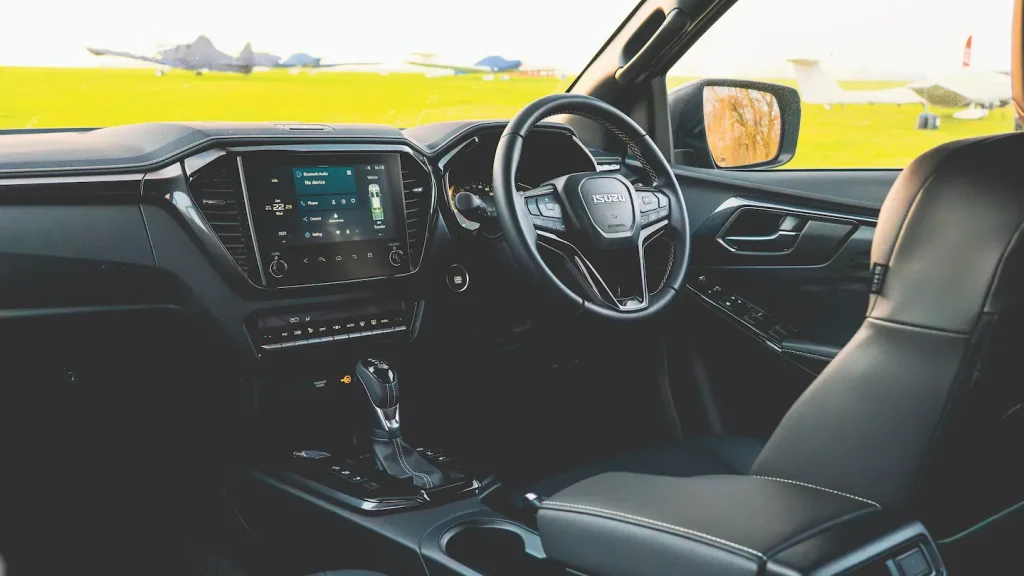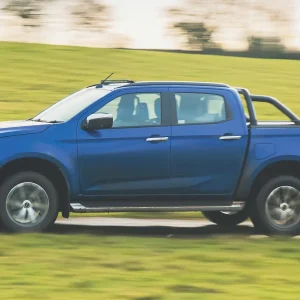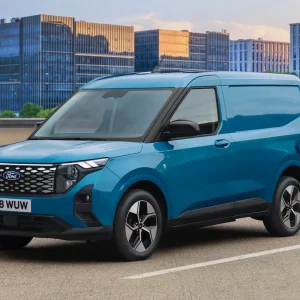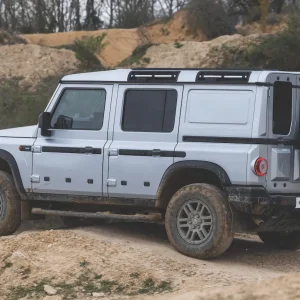
Sales of double-cab 4×4 pick-ups look set to be affected by a tax change coming into effect in April 2025, which sees them reclassified as cars for employee benefit-in-kind (BIK) tax purposes. So gone are the days when crafty sales managers could run well-specified double-cabs rather than SUVs and save themselves some cash.
Those days had probably pretty much vanished anyway given the BIK advantages of switching to an electric car rather than running a diesel or petrol model.
Isuzu is one of the 4×4 pick-up manufacturers least likely to be affected by this BIK change given that its customers tend to buy its products as working tools rather than as a tax dodge. Not that this means that its trucks are spartan – the top-of-the range V-Cross double-cab has all the goodies (leather interior trim, a heated and electrically-adjustable driver’s seat, dual-zone climate control etc etc) that buyers are likely to require, and then some.
All manufacturers of double-cab pick-ups will be hit by another change, however. Their products are also being reclassified as cars from April 2025 for capital allowance purposes.
Neither of these measures affect single- or extended-cab models.
Isuzu has just revamped the D-Max with exterior styling changes, including a new front grille and bonnet, a redesigned tailgate and restyled 18in alloy wheels. Worthy of note too are the new infotainment system with either an 8in or 9in colour touchscreen and the updated instrument panel.
Definitely worthy of note is the new rough-terrain off-road driving mode.
Derived from D-Max’s traction control system, it helps to reduce wheelspin and allocates power to the wheels with the most grip. This is achieved by fine-tuning the throttle and rapidly applying the brakes to each spinning wheel.
It can work in conjunction with the differential lock (a rear differential lock is standard on all 4×4 models) in extreme conditions.
The Advanced Driver Assistance System (ADAS) has been enhanced with a new intelligent adaptive cruise control and new traffic sign recognition functions. Extra airbags have been fitted, and D-Max has won a Euro NCAP five-star safety rating.

What has not changed is the engine. The 164hp 1.9-litre diesel is the only choice, and a more powerful alternative is clearly not on the agenda as Isuzu prioritises investment in developing battery-electric technology instead.
It plans to start selling a left-hand-drive electric 4×4 pick-up able to handle a 1.0-tonne payload and tow 3.5 tonnes in mainland Europe during the final quarter of this year. Its right-hand-drive counterpart is scheduled for launch in the UK during the first quarter of 2026.
Projected range figures have yet to be released. In the meantime, Isuzu continues to follow its established approach of splitting the D-Max range into two.
Aimed at fleet customers such as construction companies and local authorities, the entry-level Business Utility range includes single, extended and double-cabs, with the single-cab up for grabs as a 4×2 or a 4×4.
The fancier All-Purpose All-4×4 range is targeted at small businesses and the self-employed and includes the DL20 and DL40 as well as the V-Cross. Customers can opt for either an extended or a double-cab, and for either a six-speed manual or a six-speed automatic gearbox.
Driving impressions
We opted for an automatic V-Cross double-cab – the priciest model in the line-up – and took it off-road in a nightmarish, hilly, muddy swamp in Leicestershire. Despite the sopping-wet conditions and deep water, it coped with everything that was thrown at it without missing a beat.
Deploying the rough terrain mode aided our progress as we squelched up and down steep inclines.
On ordinary highways the truck rides well and delivers a seamless gearchange. Yet while in-cab noise isn’t a major issue, the engine note rapidly becomes harsh under acceleration, and the electronic power steering is a tad too light.
Admittedly it is speed-sensitive which should keep it light at lower speeds for ease of parking, while becoming heavier at higher speeds making the D-Max easier to control. The balance between the two modes seems to be a little off-kilter however, with a need for the steering to become heavier more quickly.
That said, it didn’t disrupt the handling, which was impressive for such a big, hefty truck – and the driver’s seat wins top marks for comfort.
On-road performance along a selection of A and B roads was perfectly acceptable, but buyers looking to run at maximum payload or tow a heavy trailer on a regular basis might want to look at rival products with more power than a D-Max.
In addition to the goodies listed above, the V-Cross comes with front and rear parking sensors, a reversing camera, and a keyless entry and push-button starter system. Bluetooth connectivity, a DAB radio, Apple Carplay and Android Auto are all included in the in-cab deal, while the ADAS package embraces one of our favourite safety features.
Of course, we’re talking about rear cross traffic alert and braking. It is just what you need if, for example, you have no choice other than to reverse out of a field and into a narrow country lane, and you do not want to be hit by a speeding tractor hauling a big trailer full of spuds – as the writer can testify.
| Model | Isuzu D-Max Double Cab V-Cross automatic |
| Price (ex VAT) | £38,905 |
| Price range (ex VAT) | £26,405-£38,905 |
| Warranty | 5yrs/125,000mls |
| Service intervals | 1yr/12,000mls |
| Load length | 1,520mm |
| Load width (max) | 1,530mm |
| Load bay height | 500mm |
| Payload | 1,085kg |
| Load volume | n/a |
| Engine size/power | 1,898cc/164hp |
| Combined fuel economy | 31.3mpg |
| CO2 | 235g/km |
| On sale | Now |
| Key rival | Ford Ranger Wildtrak |
| Verdict | The D-Max has been given some useful enhancements that keep the pot boiling, but we’d like to see more power. |
| Score | 6/10 |





